Facts and data on pictograms

Synonyms / Other Terms Used
Information Desk, Info, Advice
Category
Public Facilities, Services, Public Services
Message / Function
To indicate where information is to be obtained
| Source | Description | |
|---|---|---|
 |
Unknown | Text 'Info' |
 |
AIT | Letters 'INF' |
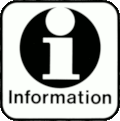 |
UIC 413 b | Lower case letter i inside circle, text 'Information' below |
 |
BVG | Small lower case block letter i plus two figures, one behind desk |
 |
EJP | Lower case letter i inside circle |
 |
ISO 7000 | Lower case letter i inside circle |
 |
British Rail | Lower case letter i inside circle |
 |
Ecuador | Lower case letter i inside arc almost froming a circle |
 |
Wiener Linien | Lower case block letter i |
 |
SADC | Lower case letter i |
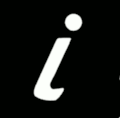 |
BTA | Lower case letter i |
 |
BS 8501:2002 | Lower case letter i |
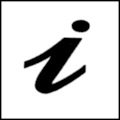 |
Unknown | Lower case letter i |
 |
ISO 7001 | Lower case block letter i |
 |
Tern | Lower case block letter i |
 |
LG | Lower case block letter i |
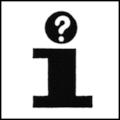 |
Unknown | Lower case block letter i with question mark inside dot |
 |
O'72 | Question mark in outline and lower case letter i |
 |
Erco | Question mark, and lower case letter i in outline |
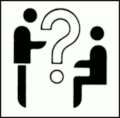 |
O'72 | Standing and seated figure with large question mark in between |
 |
ADV | Standing and seated figure with small question mark in between |
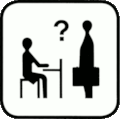 |
ADV | Standing and seated figure with small question mark in between |
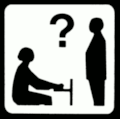 |
ICAO | Standing and seated figure with small question mark in between |
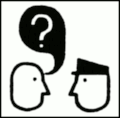 |
Unknown | Two heads facing each other, bubble with question mark |
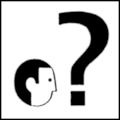 |
Expo 67 | Head facing large question mark |
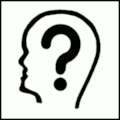 |
EZ | Question mark surrounded by head in outline |
 |
AIGA | Question mark inside a circle |
 |
Eco-Mo Foundation |
Question mark inside a circle |
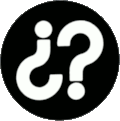 |
O'68 | Pair of question marks inside circle |
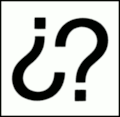 |
PORT | Pair of question marks |
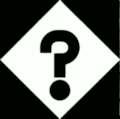 |
Expo '70 | Question mark inside rhombus |
 |
WO'72 | Question mark, fingers pointing in various directions |
 |
ICBLB | Question mark, inside arrows pointing in four directions and two diagonal lines between |
 |
ICTSS | Disk with question mark inside, surrounded by circle with three arrows pointing outwards |
 |
Unknown | Two arrows pointing in opposite directions starting at circle in the middle |
 |
O'64 | Fingers pointing in various directions |
 |
EZ | Outline rectangle with circle, larger filled rectangle below |
Discussion
The examples shown above are only a small selection from the wide range of pictograms and symbols for Information that can be found as public information symbols in guiding systems worldwide. Most concepts emerged before 1975, while later design mostly focus on variations of the letter i and question marks. In our collection we especially left out manifold variations of the letter i and question marks in use that differ in minor details only.
Gehringer (1979) used the Production Method to explore which mental images or visual stereotypes exist concerning the message 'Information'. The results were about as heterogeneous as the selection shown above with one concept dominating: the letter i was drawn by 40% of the respondents. The other images were: a book or newspaper (20%), a person at a desk (5%), and a question mark or an exclamation mark (4%). 25% produced either nothing or images that could not be used to derive any hints or ideas.
More than thirty different variants were examined in the Appropriateness Ranking Tests of the first stage of the ISO 1975 test series (Easterby & Zwaga, 1976) and the 1985/86 series (Gärling, 1985). Results were inconsistent between countries, but text versions always were ranked best. The lower case block letter i always was ranked better than the italic script variants. Versions based on the letter i mostly outperformed variants with question marks. Contrary to these results the AIGA question mark received a much better Efficiency Index - a score based on several tests - than a variant similar to the British Rail lower case block letter i inside a circle (Mackett-Stout & Dewar, 1981).
Comprehension Test results of the year 1975 were insufficient for all variants tested (Easterby & Zwaga, 1976). While the ICAO and PORT variants reached about 50% correct responses, the British Rail lower case block letter i inside a circle elicited just 35% correct responses. Particularly in Canada performance of this variant was very poor. Eleven years later the letter i worked quite well in conveying the message 'Information' in several countries except for Japan (Brugger, 1987). Inserting a question mark into the dot did not improve performance. In another study in Japan 15 years later (Eco-Mo Foundation, 2001) comprehensibility of the letter i as symbol for Information again was not successful with a comprehension score of 22.2, while the question mark inside a circle reached a score of 68.1 regarding the message Question & Answer.
When Fiori (2008) examined an Information map symbol based on the letter i in Brazil, 42.3 % answered correctly. Wrong responses were for example Internet, Cyber Cafe, (Banco) Itaú, or just Letter i.
Meanwhile the lower case letter i is the standard symbol, and it also was approved as part of Unicode 3.0 in 1999 under the name “Information Source” and added to Emoji 1.0 in 2015. Usage in various applications probably has improved comprehensibility of this symbol up to now.
Recommendation
We recommend the use of symbol PI PF 001 Information from ISO 7001.
Tests of pictograms of referent Information
Brugger, Ch. (1987): Evaluation of Public Information Symbols, ISO 1986 Test Series: Comprehension/Recognition Test. Vienna: ISO / TC 145 / SC 1.
Easterby, R.S. & Zwaga, H.J.G. (1976): Evaluation of Public Information Symbols, ISO Tests: 1975 Series. AP Report 60, Department of Applied Psychology, University of Aston, Birmingham, March 1976.
Eco-Mo Foundation (2001): Test data of public information symbols in Japan - Procedure for the testing of public information symbols by the Study Committee. ISO: ISO/TC 145/SC 1 N 329.
Fiori, S. R. (2008): Mapas para o turismo e a interatividade - proposta teórica e prática. Tese de Doutorado - Depto. de Geografia, FFLCH-USP.
Gärling, T. (1985): ISO Appropriateness Ranking Test 1985 - Redovisning av genomförande. Report to the Swedish Standards Institute dated 1985-07-24.
Gehringer, J. (1979): Untersuchung über die zeichnerische Gestaltung von Pictogrammen in Abhängigkeit von einigen Persönlichkeitsmerkmalen, sowie Überprüfung einiger Bildzeichen auf ihre Erkennbarkeit. Dissertation, Psychology Department, University of Vienna.
Mackett-Stout, J. & Dewar, R.L. (1981): Evaluation of Public Information Signs. Human Factors, 1981, 23, 139-151.
Neill, J., Hurwitz, D., & Olsen, M. (2015): Alternative Information Signs: Evaluation of Driver Comprehension and Visual Attention. Journal of Transportation Engineering. 142. 04015036. 10.1061/(ASCE)TE.1943-5436.0000807.
Rammerstorfer, U. (2005): Piktogramme als internationaler Beitrag zur interkulturellen Kommunikation. Dipl.Arb., University of Vienna.
Zwaga, H.J. & Boersema, T. (1983): Evaluation of a set of graphic symbols. Applied Ergonomics, 14, 1, 43-54.
Updated 2024-03-19 by Ch.Brugger